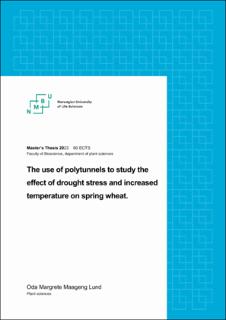| dc.contributor.advisor | Morten Lillemo | |
| dc.contributor.advisor | Tomasz Mroz | |
| dc.contributor.author | Lund, Oda Margrete Maageng | |
| dc.date.accessioned | 2023-07-15T16:28:33Z | |
| dc.date.available | 2023-07-15T16:28:33Z | |
| dc.date.issued | 2023 | |
| dc.identifier | no.nmbu:wiseflow:6839612:54592634 | |
| dc.identifier.uri | https://hdl.handle.net/11250/3079325 | |
| dc.description.abstract | An increase in wheat production will be vital to feed a growing population. Heat and drought are already causing great losses in yield, and climate change is expected to damage production in the future. Breeding for drought tolerance in wheat is therefore essential to ensure food security. To create drought conditions in this trial, two polytunnels were utilized. 16 genotypes from Norway, Sweden, Lithuania, Latvia, and Estonia were grown in polytunnels and exposed to two different temperature and irrigation treatments. The temperature treatment aimed to keep one tunnel ambient and for the temperature to increase in the other. For irrigation, it was attempted to decrease the grain yield by 50%. There were also aspirations to identify varieties tolerant to drought stress. This was the pilot season for this trial, and the first season the polytunnels were utilized. Therefore, several issues occurred during the season. These included elevated humidity due to poor ventilation and sub-par results due to a delay in achieving sufficient drought stress. However, the results from the ambient tunnel were satisfactory, and some interesting observations were made. The replicates in the ambient tunnel exposed to drought experienced a 30% reduction in yield, with the variety 013-01 being the best performing under both irrigation treatments. The treatments significantly affected all agronomic traits, and there was a significant difference between the genotypes. However, the interaction between genotype and treatment was only significant for plant height. When the varieties in the polytunnels were compared to those grown outside at Vollebekk in 2022, the majority ranked similarly regardless of treatment. The exception was DS-720-3-DH which ranked noticeably lower when exposed to drought as opposed to the NOBALwheat trial and control replicate, indicating genotype by environment interactions. These results suggest that the trial could be repeated to gain knowledge about drought tolerance in wheat. In future replications of the trial, however, it would be beneficial to improve the management of the tunnels to create better drought conditions and improve ventilation. High throughput phenotyping should also be included to gain further insight into the stress responses of the plants. | |
| dc.description.abstract | An increase in wheat production will be vital to feed a growing population. Heat and drought are already causing great losses in yield, and climate change is expected to damage production in the future. Breeding for drought tolerance in wheat is therefore essential to ensure food security. To create drought conditions in this trial, two polytunnels were utilized. 16 genotypes from Norway, Sweden, Lithuania, Latvia, and Estonia were grown in polytunnels and exposed to two different temperature and irrigation treatments. The temperature treatment aimed to keep one tunnel ambient and for the temperature to increase in the other. For irrigation, it was attempted to decrease the grain yield by 50%. There were also aspirations to identify varieties tolerant to drought stress. This was the pilot season for this trial, and the first season the polytunnels were utilized. Therefore, several issues occurred during the season. These included elevated humidity due to poor ventilation and sub-par results due to a delay in achieving sufficient drought stress. However, the results from the ambient tunnel were satisfactory, and some interesting observations were made. The replicates in the ambient tunnel exposed to drought experienced a 30% reduction in yield, with the variety 013-01 being the best performing under both irrigation treatments. The treatments significantly affected all agronomic traits, and there was a significant difference between the genotypes. However, the interaction between genotype and treatment was only significant for plant height. When the varieties in the polytunnels were compared to those grown outside at Vollebekk in 2022, the majority ranked similarly regardless of treatment. The exception was DS-720-3-DH which ranked noticeably lower when exposed to drought as opposed to the NOBALwheat trial and control replicate, indicating genotype by environment interactions. These results suggest that the trial could be repeated to gain knowledge about drought tolerance in wheat. In future replications of the trial, however, it would be beneficial to improve the management of the tunnels to create better drought conditions and improve ventilation. High throughput phenotyping should also be included to gain further insight into the stress responses of the plants. | |
| dc.language | eng | |
| dc.publisher | Norwegian University of Life Sciences | |
| dc.title | The use of polytunnels to study the effect of drought stress and increased temperature on spring wheat. | |
| dc.type | Master thesis | |
